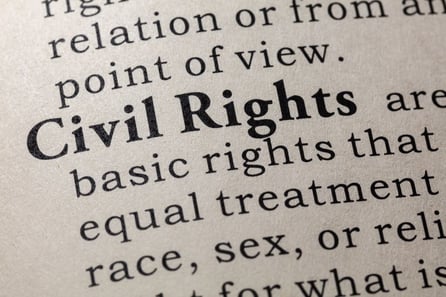Is this all? Well-educated middle-class suburban women in the early 1960s begin to push back
 In the early 1960s, the United States was no longer a farming country; only 30% lived in rural areas. Prosperity was high, 60% of families lived in homes they owned, and 75% owned a car. A quarter of all families lived in the suburbs. Jackie Kennedy was the ultimate “corporate wife” role model, and it appeared that the American dream was fulfilled. Housework was easier than in years past, and women had more time on their hands.
In the early 1960s, the United States was no longer a farming country; only 30% lived in rural areas. Prosperity was high, 60% of families lived in homes they owned, and 75% owned a car. A quarter of all families lived in the suburbs. Jackie Kennedy was the ultimate “corporate wife” role model, and it appeared that the American dream was fulfilled. Housework was easier than in years past, and women had more time on their hands.
And then, one woman asked in a book that sparked a movement, “Is this all?” Betty Friedan published The Feminine Mystique in 1963 in response to her own restlessness as well as the women around her. Her book validated the unhappiness that many women in the 1960s were feeling. She shared that well-educated middle-class suburban women were being duped into believing that housework was satisfying and that, in essence, “the feminine mystique has succeeded in burying millions of American women alive.” The book was a call to action and a call for outside employment. The book inspired women all over, and women began to question what was right for themselves.
Women Work Politically to Make Changes. While Friedan was asking suburban women if they were satisfied, other women were working politically to make a change. Each year, Alice Paul led the National Women’s Party to Congress to request the introduction of the Equal Rights Amendment or ERA. Alice Paul was instrumental in the suffrage movement in the early 20th century and continued to fight for the ERA, which was first introduced in 1923 as a constitutional amendment barring discrimination on the basis of sex.
➡️➡️Read More: Women In the Workforce: 08_The Myth of the Ideal Woman
The ERA was controversial because many believed that by solidifying legal equality, laws which protected women, such as reduced working hours or prohibiting military service, would be dismissed. Although the ERA was not a pressing issue at the time, President Kennedy was beginning to feel the pressure that his administration was not doing enough for women’s issues. He formed a special Presidential Commission on the Status of Women and asked Eleanor Roosevelt to serve as the symbolic head. The commission was like many committees in government, and it produced a well-meaning but useless report on the status of women. But more importantly, it brought together many women who might never have met, and they discussed women’s rights, a subject that rarely came up at the time. These women pushed for the Equal Pay Act, which Kennedy signed into law in 1963, and many of these women would later be involved in the women’s movement in more fundamental ways.
Although life in the 1960s looked like the decade before for most white suburban families, the nation was changing. The early 60s continued the long fight for civil rights. The fights did not take place in the white suburbs, but the news showed horrific and unsettling scenes from the sit-ins, Freedom Riders, and the Freedom Summer. In 1963, President Kennedy asked Congress for a comprehensive Civil Rights bill, and after his assassination, President Lyndon Johnson signed into law the Civil Rights Act of 1964, which prohibited discrimination based on race, color, sex, religion, or national origin and included Title VII which prohibited discrimination in employment by hiring, firing, and promoting.
 How Sex Was Added to The Civil Rights Act. A little-known story about this important bill is how the word “sex” was added. The Civil Rights Act was at the top of the list of bills that Representative Howard Smith of Virginia wanted to stop. When it came up for a vote on the House floor, he offered an amendment that would add women. He offered the change as a joke believing that adding women would actually kill the bill. He even read funny letters and told “yes, dear” jokes as part of his speech. As the male legislators laughed at Smith’s ridiculous addition, Representative Martha Griffiths of Michigan rose and stated, “I presume that if there had been any necessity to point out that women were a second-class sex, the laughter would have proved it.”
How Sex Was Added to The Civil Rights Act. A little-known story about this important bill is how the word “sex” was added. The Civil Rights Act was at the top of the list of bills that Representative Howard Smith of Virginia wanted to stop. When it came up for a vote on the House floor, he offered an amendment that would add women. He offered the change as a joke believing that adding women would actually kill the bill. He even read funny letters and told “yes, dear” jokes as part of his speech. As the male legislators laughed at Smith’s ridiculous addition, Representative Martha Griffiths of Michigan rose and stated, “I presume that if there had been any necessity to point out that women were a second-class sex, the laughter would have proved it.”
This got their attention, and eleven of the 12 female representatives rose to support the addition of women to the Act. The one hold-out was Edith Green of Oregon, who felt that black Americans had to come first. She said, “For every discrimination that has been made against a woman in this country, there have been ten times as much discrimination against the Negro.” However, Griffiths felt that by adding the prohibition based on sex, both black and white women would be able to take a modest step forward together. The amendment passed the House as well as the Senate. Years later, when retired Representative Smith ran into Martha Griffiths, she commented about the good that their amendment had done, and he replied, “Martha, I’ll tell you the truth. I offered it as a joke.”
➡️➡️Read More: Women in the Workforce: 07_A Woman's Place
Representative Smith was not the only one who thought that providing women equal protection in the workplace was funny. Jokes were everywhere, citing the new law as the “Bunny Law,” with lots of fodder around the many unshapely men who would apply to be Playboy bunnies or chorus line dancers.
 Title VII of the Civil Rights Act created the Equal Employment Opportunity Commission (EEOC) to implement the law, but it did not focus on sex discrimination. The first commission only had one female, and it ruled that help wanted ads could no longer mention a preferred race but did nothing to stop the classifieds from being separated by gender. Surprisedly, the first complainants to the EEOC were not men interested in being a Playboy bunny, nor were they oppressed black men as expected - they were airline stewardesses. They complained about the airline ban on marriage, age discrimination, and constant weight checks. When a hearing was held on the issue, one male representative jokingly said to the female flight attendants, “Stand up so we can see the dimensions of this problem.”
Title VII of the Civil Rights Act created the Equal Employment Opportunity Commission (EEOC) to implement the law, but it did not focus on sex discrimination. The first commission only had one female, and it ruled that help wanted ads could no longer mention a preferred race but did nothing to stop the classifieds from being separated by gender. Surprisedly, the first complainants to the EEOC were not men interested in being a Playboy bunny, nor were they oppressed black men as expected - they were airline stewardesses. They complained about the airline ban on marriage, age discrimination, and constant weight checks. When a hearing was held on the issue, one male representative jokingly said to the female flight attendants, “Stand up so we can see the dimensions of this problem.”
Again, Representative Martha Griffiths did not find this funny. When the airlines insisted that businessmen wouldn’t want to fly if women who gave them coffee were unattractive, she responded, “What are you running, an airline or a whorehouse?”
A Movement Begins. When it became clear that the EEOC had no intention of protecting female workers, women began to organize. With the popularity of her book, Betty Friedan became a natural leader. During the summer of 1966, at a conference of state commissions on the status of women, a group met in Friedan’s hotel room to discuss how to organize. Ideas ranged from starting a female version of the NAACP to a simple proclamation against discrimination. After hours of debate - with Friedan locking herself in the bathroom - a resolution was drafted, and the National Organization for Women(NOW) was created. Everyone pitched in five dollars to get the organization started, and a movement began.
NOW started by picketing EEOC offices nationwide and championing the legal cases of women who had been discriminated against. The women who started NOW understood the law and how to use the media effectively, but they did not have the infrastructure to grow a mass movement and did not have the legal help to take on the number of cases proposed. Friedan wrote, “With no money, no office, no staff, it was impossible to answer all the letters and calls from women who wanted to join NOW. When someone would get so impatient that she’d call long-distance … I’d make her the local NOW organizer – if she didn’t sound too crazy.”
➡️➡️Read More: Women in the Workplace: 06_Stay Home or Be Paid Less
An Important Legal Victory. NOW’s most important legal victory was Weeks v. Southern Bell. Lorena Weeks had been denied a promotion from a clerk to a switchman’s position. She was told that it was because men are the breadwinners and women don’t need this type of job. She filed a complaint with the EEOC and lost her case because Southern Bell used an argument that employers could declare a job was for men or women only if there was a reasonable qualification that only one sex could fulfill. In Weeks’ case, the new position would require her to move equipment over 30 pounds which was allegedly too much for a woman. (Never mind that her typewriter, which had to be removed from the desk each night, was 35 pounds.) This was a loophole, and the NOW legal team wanted to clarify it. After bringing in large items for NOW’s attorney, Sylvia Roberts, to move in court, the Fifth Circuit of Appeals decided in favor of Lorena Weeks. It was an important victory and showed that women could choose whether they wanted non-traditional jobs, not employers. She eventually received $31,000 in back pay and the switchman’s job.
The movement continued to grow and evolve as additional forces contributed to the trajectory of the women’s movement. For one, the economy was growing, and more women were needed in the workforce. Jobs were changing, and there was a need for fewer laborers and more customer service representatives. In 1966, President Johnson even urged employers to hire “women, teenagers, the handicapped, and immigrants” to fill the vast number of job openings. Recruiters were targeting stay-at-home moms to meet the supply. Two-thirds of new jobs in the 1960s went to women. The economy continued to grow, and consumers kept buying. Advertisements and media highlighted the good life, which was expanding to include two cars, multiple televisions, and entertainment for the kids.
Women in the Workforce: We Can Do It!
Whether married or single, with children or not, working part-time, full-time, or even two jobs, as a stay-at-home mom or a community volunteer, American women can do it! Throughout history, American women always have. And I am so proud we do! Over the next few months, I will explore how topics about women in the workforce from the early 1900s until the present. Also, I want to note the changing trends of women in the workforce that this series contemplates will focus on white, middle-class women. Women of color have had very different experiences, and their work lives have been defined by racism, sexism, and financial necessity. I have pointed this out when possible, but please keep in mind that this series is not a complete picture of all women. .
This is Part 9 of a 14-part series, Women in the Workforce: We Can Do It!, which explores topics related to the history, challenges, and accomplishments of working women in America. Topics to date include: 01_Women in the Workforce: We Can Do It!, 02_The War Opens the Doors for Working Women, 03_Rise of Jobs, Rise of Inequality, 04_Working Women and The Great Depression, 05 The Rise of Female Empowerment, 06_Stay Home or Be Paid Less and 07_A Woman's Place, and 08_The Myth of the Ideal Woman.
Propel HR President Lee Yarborough
 “My father, Braxton Cutchin, and I founded the company in 1996. After being in the PEO and HR world for 25 years, I have experienced firsthand the value we can provide to both the clients and the employees. It is truly a win for all parties. I’m proud to have helped establish Propel HR as an industry forerunner in the Southeast. There is nothing I love more than receiving phone calls from clients who seek my advice as a trusted advisor. This is a business where I feel that I can help others, and that is important to my own value.”
“My father, Braxton Cutchin, and I founded the company in 1996. After being in the PEO and HR world for 25 years, I have experienced firsthand the value we can provide to both the clients and the employees. It is truly a win for all parties. I’m proud to have helped establish Propel HR as an industry forerunner in the Southeast. There is nothing I love more than receiving phone calls from clients who seek my advice as a trusted advisor. This is a business where I feel that I can help others, and that is important to my own value.”
-- Lee Yarborough, President, Propel HR
Active in many professional and community organizations, Lee recently served as Chair of the Board of Directors of the National Association of Professional Employer Organizations (NAPEO). As NAPEO Chair, Lee focused on diversity and initiatives to deepen member relations. Under her leadership, she formed Women in NAPEO (WIN), a networking group designed to engage, empower, and encourage women working in the PEO industry. On the local level, Lee also served as the Chair of NAPEO’s Carolinas Leadership Council for more than a decade. In 2015, she was named a Fellow of the eleventh class of the Liberty Fellowship Program and a member of the Aspen Global Leadership Network.
An advocate for public education, Lee has served on the executive board as Chair of Public Education Partners and is the founder and director of Read Up Greenville, a young adult and middle grades book festival in downtown Greenville, SC.
When she breaks from board meetings, client visits, and networking, most likely, you will find Lee reading, camping, or spending time with her family. She also enjoys volunteering at her church and staying involved with her children's schools.
 About Propel HR. Propel HR is an IRS-certified PEO that has been a leading provider of human resources and payroll solutions for more than 25 years. Propel partners with small to midsized businesses to manage payroll, employee benefits, compliance and risks, and other HR functions in a way that maximizes efficiency and reduces costs. Visit our new website, www.propelhr.com.
About Propel HR. Propel HR is an IRS-certified PEO that has been a leading provider of human resources and payroll solutions for more than 25 years. Propel partners with small to midsized businesses to manage payroll, employee benefits, compliance and risks, and other HR functions in a way that maximizes efficiency and reduces costs. Visit our new website, www.propelhr.com.









